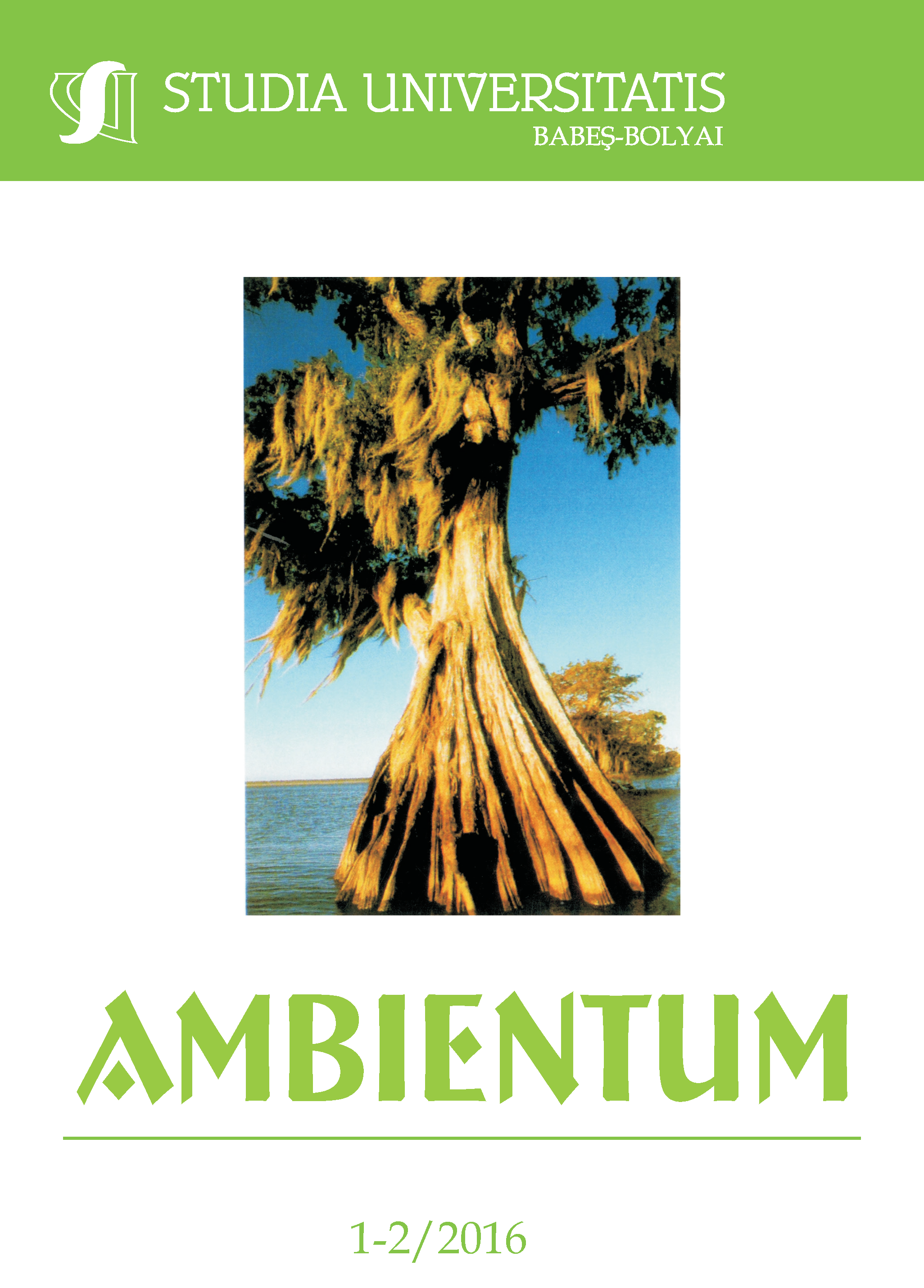PHYTOREMEDIATION PLANNING IN THE CASE OF FORMER INDUSTRIAL SITES
Keywords:
phytoremediation, planning process, former industrial sites, soil contaminationAbstract
Contaminated soils from former industrial sites need urgent measures of treatment in order to be used for other purposes. Because of the large spaces that industrial sites usually occupy, green technologies have to be chosen to treat the soil while protecting the environment. Phytoremediation is an environmentally friendly technology that uses plants to decontaminate soils. The main advantage is the low cost compared to other techniques and the main disadvantage is the time factor because phytoremediation requires long period of time to treat the polluted soil. This paper presents specific features that must be taken into consideration when planning and implementing phytoremediation projects. Pollutants concentration and soil properties limit the application of phytoremediation. A clean-up plan is prepared taking into consideration limiting factors and then the remediation measures are implemented. The project needs long-term monitoring to determine the quantity of contaminants in soils during its implementation. The main purpose is to provide a safe environment for humans’ health while improving the ecological situation of the former industrial sites.
References
Ali H., Khan E., Sajad M.A., 2013, Phytoremediation of heavy metals – Concepts and applications. Chemosphere, 91, pp. 869-881.
Asante-Duah D.K., 1995, Management of contaminated site problems. Boca Raton: Lewis Publishers.
Boroş M.-N., Micle V., 2014, Study on the application of phytoremediation of contaminated industrial sites. Scientific Papers. Series E. Land Reclamation, Earth Observation & Surveying, Environmental Engineering, Vol. III, pp. 99-107.
Filippis L.F. De, 2015, Role of phytoremediation in radioactive waste treatment. In: Soil Remediation and Plants, Hakeem K.R., Sabir M., Ozturk M., Mermut A.R. (eds.), Elsevier Inc., pp. 207-254.
Finger S.E., Church S.E. and von Guerard P., 2007, Potential for Successful Ecological Remediation, Restoration, and Monitoring, Church S.E., von Guerard P., and Finger S.E. (eds.), Integrated Investigations of Environmental Effects of Historical Mining in the Animas River Watershed, San Juan County, Colorado, Chapter F, Reston, Va.: U.S. Dept. of the Interior, U.S. Geological Survey, pp. 1067-1078.
Fujinaga A., 2016, Risk evaluation for remediation techniques to metal-contaminated sites. Environmental Remediation Technologies for Metal-Contaminated Soils, Hasegawa H., Rahman I.M., Rahman M.A. (eds.), Springer, Japan, pp. 231-254.
Ibrahim M., Adrees M., Rashid U., Raza S.H., Abbas F., 2015, Phytoremediation of Radioactive Contaminated Soils, In: Soil Remediation and Plants, Hakeem K.R., Sabir M., Ozturk M., Mermut A.R. (eds.), Elsevier Inc., pp. 599-627.
Kondolf G.M. and Micheli E.R., 1995, Evaluating stream restoration projects: Environmental Management, 19, pp. 1–15.
Kvesitadze G., Khatisashvili G., Sadunishvili T., Ramsden J.J, 2006. Biochemical mechanisms of detoxification in higher plants. Basis of Phytoremediation. Springer, Verlag Berlin Heidelberg, 4, pp. 185-194.
Loures L. and Panagopoulos T., 2007, Recovering Derelict Industrial Landscapes in Portugal: Past Interventions and Future Perspectives. Proceedings of the Int. Conf. on Energy, Environment, Ecosystems & Sustainable Development, July 24-26, Agios Nicolaos, Crete, Greece, pp. 116-121.
Macek T., Mackova M., Kucerova P., Chroma L., Burkhard J., Demnerova K., 2002, Phytoremediation, In: Biotechnology for the Environment: Soil Remediation, Agathos S.N. and Reineke W. (eds.), Kluwer Academic Publishers, the Netherlands, pp. 115-137.
Marcotullio P.J., Braimoh A.K., Onishi T., 2008, The impact of urbanization on soils. In: Vlek P.L.G. (ed.) Land use and soil resources, Springer, Netherlands, pp. 201–250.
Meuser H., 2013, Soil Remediation and Rehabilitation: Treatment of Contaminated and Disturbed Land, Environmental Pollution 23, Springer Science Business Media Dordrecht, 408 p.
Mudgal, V., Madaan, N., Mudgal, A., 2010. Heavy metals in plants: phytoremediation: Plants used to remediate heavy metal pollution. Agriculture and Biol. J. North Am., 1 (1), pp. 40–46.
Russell D.L., 2012, Remediation Manual for Contaminated Sites, CRC Press, Taylor & Francis Group, LLC, pp. 205-230.
Sas-Nowosielska A., Kucharski R., Malkowski E.. 2005, Feasibility Studies for Phytoremediation of Metal-Contaminated Soil, in: Margesin R., Schinner F. (Eds.), Manual for Soil Analysis – Monitoring and Assessing Soil Bioremediation, Springer-Verlag Berlin Heidelberg, pp. 161-177.
Simeonova B., Simeonov L., 2006, Planning and execution of a pilot phytoremediation experiment, Simeonov L., Chirila E. (eds.) Chemicals as Intentional and Accidental Global Environmental Threats, NATO Security through Science Series, Springer Netherlands, pp. 297-302.
Soesilo J.A., Wilson S., 1997, Site Remediation: Planning and Management, CRC Press, pp. 363-375.
Surriya O., Saleem S.S., Waqar K., Kazi A.G., 2015, Phytoremediation of soils: prospects and challenges, In: Soil Remediation and Plants, Hakeem K.R., Sabir M., Ozturk M., Mermut A.R. (eds.), Elsevier Inc., pp. 1-36.
Zhang J., Pu L., Peng B., Gao Z., 2011, The impact of urban land expansion on soil quality in rapidly urbanizing regions in China: Kunshan as a case study, Environ. Geochem. Health., Apr: 33 (2), pp. 125-35.
***CARBERNET, 2006, Sustainable brownfield regeneration: CARBERNET network report. Land quality management report, University of Nottingham.
***EPA, 2000, Introduction to phytoremediation. National Risk Management Research Laboratory.
***EPA, 2001, Brownfields Technology Primer: Selecting and Using Phytoremediation for Site Cleanup (EPA 542- R-01-006). Office of Solid Waste and Emergency Response (5102G), US.
***EPA, 2008, EPA Guidelines for Environmental management of on-site remediation.
***ITRC – The Interstate Technology & Regulatory Council, 2006, Planning and Promoting Ecological Land Reuse of Remediated Sites, Technical and Regulatory Guidance, Ecological Land Reuse Team.
***USEPA – Environmental Protection Agency, 2010, International brownfield case study: Emscher Park, Germany.
Downloads
Published
How to Cite
Issue
Section
License
Copyright (c) 2016 Studia Universitatis Babeș-Bolyai Ambientum

This work is licensed under a Creative Commons Attribution-NonCommercial-NoDerivatives 4.0 International License.





 ISSN (online): 2065-9490 | ISSN (print): 1843-3855 | ISSN-L: 2065-9490
ISSN (online): 2065-9490 | ISSN (print): 1843-3855 | ISSN-L: 2065-9490